There is no Xmas without… Panettone
Among raisins and candied fruit is certainly one of the most beloved Christmas sweets: the Panettone!
It ‘a typical cake from Milan, associated with the culinary traditions of Christmas and widespread throughout Italy.
The traditional panettone of Lombardy is known that high, but there is also the variant low and wide of Piedmont, called Galup.
HISTORY
The origins of panettone sometimes fade into legend.
There are two stories that enjoy greater credit:
The first tells of Messer Ughetto of Atellani, falconer, lived in Contrada delle Grazie in Milan. In love with Algisa, beautiful daughter of a baker, he became the father take her as an apprentice, and to increase sales, he tried to invent a dessert: the best kneaded flour mill eggs, butter, honey and raisins. Then it baked.
It was an amazing success, everyone wanted to try the new bread and some time later the two young lovers were married and lived happily ever after.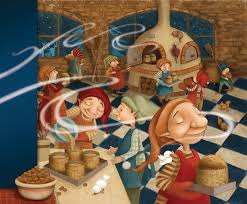
The second tells of a cook in the service of Ludovico il Moro that was instructed to prepare a sumptuous Christmas dinner to which were invited many nobles of the district, but the sweet, forgotten in the oven, almost charred. Given the desperation of the cook, Toni, a little kitchen boy, proposed a solution: “With how much is left in the pantry a little ‘flour, butter, egg, lime zest and some raisins this morning I cooked this cake. If you have nothing else, you can bring it to the table”. Cook agreed and, trembling, stood behind a curtain to spy on the reaction of the guests. Everyone was thrilled and the Duke, who wanted to know the name of that delicacy, the chef revealed the secret: “This is’ the bread of Toni.” Since then it has the “Pan de’ Toni”, or the “Panettone”
But the true origin of the cake to be found in the custom prevalent in the Middle Ages to celebrate Christmas with a bread richer than everyday. A late fifteenth century manuscript of George Valagussa, preceptor of the house of Sforza, attests to the ducal habit of celebrating the so-called rite of Ciocco:
On the evening of December 24 was placed in the fireplace a big piece of wood and, at the same time, they were brought to the table three large loaves of wheat bread, a great value for the era. The householder gave a slice to all diners, holding one for the following year, as a sign of continuity.
Another historical reality supports the derivation of the Panettone from the large wheat Christmas bread:
up to 1395 all furnaces Milan (except the “prestino dei Rosti”, provider of the most well-off) were allowed to bake wheat bread only at Christmas, to pay homage to their regular customers.
The habit of wheaten bread at Christmas, then, is very old. No wonder, because many other Italian and European cities shared the tradition of the enriched feasts bread.
Only that of Milan, however, has become the Panettone.
Some stages of this long evolution are documented. In 1606, according to the first Milanese-Italian Dictionary (Varon milanes), the “Panaton de Danedaa” was a “pan grosso” (big bread), which is usually done on Christmas Day, metaphor for an inept [sic], slothful.Francesco Cherubini gives us a more rich description in his famous Milanese-Italian vocabulary in five volumes (printed between 1839 and 1856. the third volume M-Q is from 1841). The “Panattón or Panatton de Natal” as a species of wheat bread decorated with butter, eggs, sugar and raisins (ughett or sultana), which, intersected like almond when dough, once cooked it is to many croissants. Great one or more pounds we usually only do at Christmas, of equal or similar dough but called “panellini” are made all year around by “offellai” and we call them “Panattonin” – In the countryside instead the Panatton is usually made with turkish wheat flour and filled with apples cloves and grapes […].
The first source to mention yeast, however, is of 1853: the New Economic Milanese chef, cookbook from John Felice Luraschi. The diced candied fruit (cedar) appear in the Treaty of kitchen, modern pastry (1854) from Giovanni Vialardi, chef of kings of Savoy.
The presence of the panettone into a nineteenth century Piedmontese book proves the antiquity of the spread of this sweet in the region chosen by Flamigni as the site of its production plants. Pietro Verri tells the story of an ancient custom that in the ninth century animated the Christian festivities linked to the Milan area: at Christmas the whole family would gather around the hearth waiting for the pater familias would break “a large bread” and gave it a piece at all present as a sign of communion.
In the fifteenth century, as ordered by the ancient statutes of the guilds, the bakers in the shops of Milan kneaded the bread of the poor (millet bread called pan de MEJ), it was forbidden to produce the bread of the rich and nobles (white bread, said micca ). With only one exception: on Christmas Day, when aristocrats and plebeians could eat the same bread, given by the bakers to their customers.
It was “pan di scior” or “pan de ton”, ie the bread of luxury, pure wheat, stuffed with butter, honey and raisins. At the end of the eighteenth century there was an unexpected novelty: the Cisalpine Republic undertook to support the work of milanese artisans and merchants, favoring the opening of the ovens, the world of delights where the “prestinee” busy darting, and pastries, enchanted kingdom of “offellee”.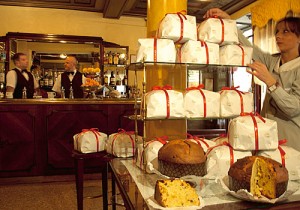
In the nineteenth century, during the Austrian occupation, the panettone becomes the irreplaceable character of a yearly habit: the governor of Milan, Ficquelmont, he used to offer it as a personal gift to Prince Metternich. The recipe of the panettone is taken by Angelo Vergani in 1944, founder of Vergani, a company that still produces the panettone in Milan. The poet Pastori, one of the most popular milanese poets of the ‘900 mentions this type of cake in one of his poems.
Recipe
The formats of the panettone
Panettone, today, is available in two formats: low and high. From the first was born the second, but the second has indirectly made to evolve the first. Retrace his steps.
The original low panettone.
As its name says, the panettone was once a big bread, which until the early twentieth century was baked without any kind of mold [to get an idea of how it was]. The thing was possible, because the amount of fat contained in it was quite modest; nothing to do with the 6 ÷ 700 grams of butter per kilo of flour and the many yolks used today by many confectioners (pushing up and baking a modern panettone without sheaths, in fact, the result would be a flattened focaccia, not a Panettone).
The high panettone.
Is Angelo Motta to change things. In the twenties, perhaps influenced by the work for a batch of two hundred kulic for the Russian community in Milan, definitely determined to enrich its Panettone of fats, decided to wrap it with straw-paper, to give it a vertical thrust. From this idea is developed the panettone fungus, shape that for decades has become the classic shape of the industrial product. The pastry shops in Milan, however, have continued to do panettone-loaf.
At first, no bands (or paper cups, as it’s called today its form in one piece), then with short paper cups, made indispensable by the amount of the fats used. Today the two formats coexist and it is difficult to say which is the more traditional, as is the panettone itself to be changed.
Ingredients for one panettone of 1.5 kg
Half Manitoba flour and half 00 500 gr (or 500 gr of all pourpose floor)
Dry Yeast 5 gr
Milk 60ml
Medium-large eggs 4 whole and 3 egg yolks
Sugar 160g
Salt 5 grams
The grated rind of one lemon
Orange candied fruits 40 gr
Citron candied fruits 40 g
Raisins 120 gr
1 vanilla berry
Butter 160 gr
Malt or sugar 1 teaspoon
Preparation
To prepare the panettone it requires 3 steps of manufacturing, below we report for each stage the necessary ingredients, in order to make more clear the execution of the recipe.
STEP ONE:
Flour 100g
Yeast 10 gr
malt 1 teaspoon (or sugar)
60 ml milk.
First, soak the raisins to revive her. Dissolve 10 grams of yeast and malt (or sugar) in 60 ml of warm milk, then add the flour and knead until get a smooth and homogeneous dough that you will put in a bowl covered with plastic wrap to rise to 30 ° up to a doubling of the volume (about 1 hour).
STEP TWO:
You’ll have to add to the first mixture:
180 g flour;
yeast 2 grams;
2 whole eggs;
soft butter 60 g;
60 g sugar.
Combine to the first leavened dough eggs, crumbled yeast and flour, knead with your hands then add the sugar and finally the butter softened at room temperature; knead until mixture is smooth and not sticky put in a bowl cover with plastic wrap and leave to rise to 30 ° C for about two hours, or until the doubling the volume.
STEP THREE:
Add to the second dough:
220 g flour,
100 grams sugar,
2 whole eggs and 3 yolks,
salt 5 grams,
100 grams soft butter,
grated rind of 1 organic lemon,
diced candied orange 40 g,
diced candied citron 40 g,
120 g raisins,
1 vanilla berry.
Add the 2 eggs and 3 egg yolks and 220 grams of flour.
Knead for 10 minutes so that the mixture takes a nice smooth consistency, then add the sugar and salt.
When all the ingredients are absorbed, add the softened butter in two times and, thereafter, the candied fruit (orange and citron) the grated lemon rind, raisins previously soaked (if you want you can soak in rum or other liquor to your liking) and squeezed; if you like can add other flavors as you wish to strengthen the fragrance mix (orange, lemon, vanilla, rum, etc …).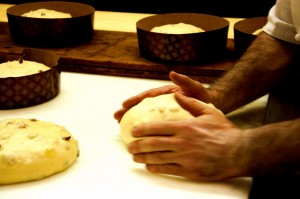
Leave the dough to rise at 30 ° by putting it in a bowl covered with plastic wrap until the doubling of its volume (at least 2 hours). Meanwhile, buttered and lined a mold for panettone (diameter will be 18 cm and 10 cm high, if not have it you can use two paper cups of 750 grams each) with greaseproof paper (or use a paper mold for panettone) and when the volume of the ‘dough has doubled, remove it from the bowl, knead again on a slightly floured surface and give it a spherical form: place it inside the mold with the smoother part upward. Let rise covered until the dough does not come to the edge of the mold (at least two more hours).
When the dough is flush with the mold, put it in a ventilated place for 10 to 15 minutes so that a kind of film drier is formed on the surface, then carve a cross on the top and place in the center of the cross a cube of butter (the size of a walnut). Put on a baking sheet on the bottom of the oven with a bowl of water beside and bake at 200° for about 10 – 15 minutes, then lower to 190° and cook for another 10 to 15 minutes. If the surface is too dark or tended to color too quickly, lower still at 180° and continue cooking. In total, the panettone will bake for 1 hour. Once cooked, remove the panettone from the oven and let cool. Your cake is now ready to be served !!! Happy Holidays!!!
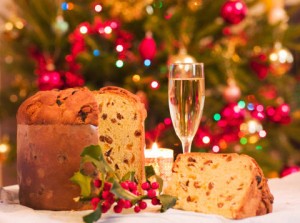





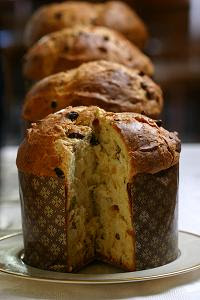
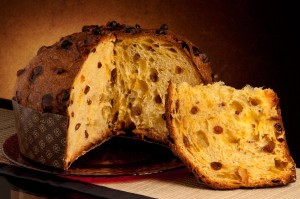

Leave a comment